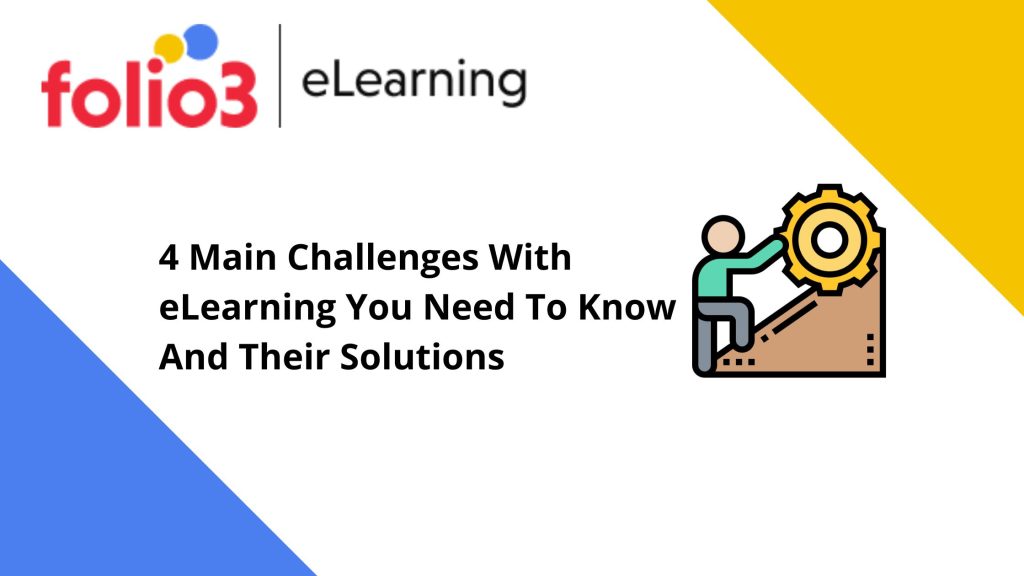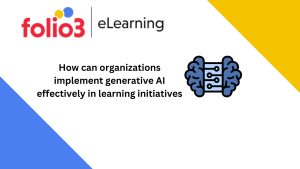
The COVID-19 pandemic paralyzed the whole planet. However, as the virus spread, few things underwent as much change as the educational system did. Corporations hurried to develop alternatives to help people continue their education/training after the abrupt interruption and overcome the challenges with eLearning.

The Executive Summary
The use of ICT, Web 2.0 applications, and the effects these technologies are bringing on education have brought many new challenges to eLearning. These challenges of an elearning environment differ from a typical classroom and can be more difficult for the instructors and trainees involved. Hence, to ensure success in eLearning solutions, it is important to recognize the problems and take best practice solutions into consideration discussed in this article.
What Are The Challenges Of Online eLearning?
Even though eLearning solutions are the newest trend in education, it is already doing admirably despite the challenges online learning presents for trainers and trainees. Trainees must arm themselves with the technical prowess to decode the course material, while trainers must put in a lot of effort and time to construct the lesson. In eLearning classrooms, trainees frequently experience the following problems with elearning that must be resolved for the sake of the trainee’s long-term success.
1) Resistance To Adaptability
The learning experience is completely different for trainees when they switch from traditional classroom training with a face-to-face instructor to computer-based instruction in a virtual classroom. They struggle to adjust to the online learning environment due to their reluctance to change, whereas it takes some time for them to get used to Course Management Systems (CMS) and computer-based learning techniques.
While passive listening and notes taking are expected in a traditional classroom, online discussions or creating a web page demand springing into action. Trainees with a “traditional” mindset find it difficult to adapt; however, they need to accept the new learning circumstances with an open mind and heart. Understanding the benefits of eLearning and even discussing them with their peers may change this mindset and better prepare trainees for online classes.
2) Course Designing
Poorly designed online learning experiences can be greatly influenced by a lack of time spent on course planning and design, which is a significant difficulty for e-learning instructors. A crucial factor to consider is the duration of time it takes to plan and implement an effective online course. Because of the new content, new technologies, and new strategies for involving online learners, it appears that instructors reported spending more time creating e-learning courses.
The difficulty of finding the time to construct an online course can be overcome by instructors who frequently cooperate within their eLearning networking. Working together with other educators should involve sharing, growing, and creating. This collaboration and dialogue reduce the amount of time spent researching and developing. With the trainee in mind, a solution to the problem of an excellent general course design must be discussed and should incorporate the following general course characteristics:
- possibilities for trainees to work together
- a well-known communication protocol
- specific performance standards
- chances for trainees to decide how tasks are prepared and presented.
These qualities are crucial to the entire course design and e-learning environment for trainers and learners to succeed.
3) Technical Problems
Gen Z and Millennial generations are often adept at using technology. However, this does not imply that they never experience technological difficulties. Individuals who study on computers must be able to use various programs, some of which have challenging learning curves.
The IT department might be quickly contacted for assistance if a learner is on a physical campus and experiencing technical difficulties. The student is forced to work things out independently when taking lessons online. If they’re lucky, they’ll have someone around to assist them, but it’s likely that person won’t be on hand constantly.
Here are some steps they might do to overcome the challenges of learning to lessen the technological problems that both learners and instructors have during online classes:
Students should ensure access to the technology needed to succeed at home before registering for an online course. If they don’t, they should see if the institution provides technical support for online students (through phone, email, and live chat).
Students and instructors should utilize a reliable ISP for online programs to ensure a quick connection. If they don’t have a reliable ISP at home, they can use the free Wi-Fi at a nearby coffee shop or public library.
4) Learner Engagement
The major duty of the teacher or course designer is to create the ideal online atmosphere where students desire to study and feel successful, even though true active learning can only occur spontaneously. Today’s online learning settings lack tech assistance, face-to-face or f2f engagement, and teacher presence. Even the most carefully designed and properly laid out online learning environment cannot keep learners interested or encourage intrinsic motivation. On the other hand, learners who are new to custom eLearning environments often don’t have the level of self-directed learning, time management, or metacognition awareness required to succeed.
The teacher’s main responsibility in fostering learners’ motivation is to foresee and address the motivating difficulties specific to online learning. Increasing face-to-face encounters using various digital forms is one approach to this. It’s not necessary to limit classroom interactions in eLearning to just web-based interactions and email contact. Learners need to feel connected, comforted, and comfortable to participate in their new learning environments because they frequently experience anxiety when learning online. The lack of a wide range of communication choices in eLearning environments often results in an unwelcoming learning environment that can only be managed by the teacher. By using tools like Skype, chat rooms, or discussion boards, e-mentors should offer a variety of alternate ways for students to interact and communicate to reduce their fear.
The Conclusive Thoughts
The strategy that a majority are now using doesn’t work: More than 40% of workers say that the conformity and ethical training they underwent in the previous year did not improve their ability to do their jobs, according to Gartner.
Your corporate elearning solution may conduct efficient online training by addressing the four elearning challenges we’ve discussed in this post. So here are our main conclusions:
- Before making a purchase, decide on an educational technology budget and test out some goods that fall within that range so you don’t spend much on something your trainee may resist.
- Make absolutely sure every custom eLearning you produce is brief, simple, and worthwhile.
- Recognize the drawbacks of online learning and, as needed, seek out support from online learning groups and prepare course libraries to provide apt technical support beforehand.
- Create a searchable database of evergreen training resources and have a plan for reinforcing what employees learn online.
This was our take on the elearning challenges. We hope you find understandable information in our article, unlike other elearning articles, which will help you unknot some of the problems you may have faced while working with eLearning solutions.










